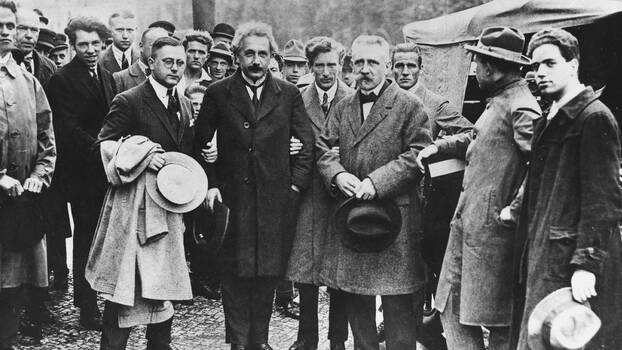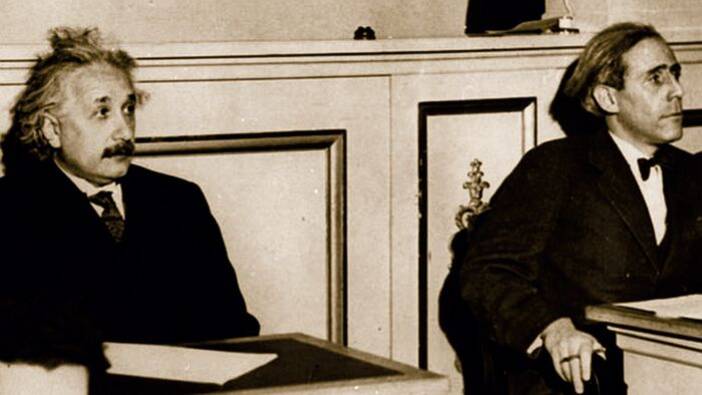
December 2023 marks the seventy-fifth anniversary of the passage of the Universal Declaration of Human Rights. Passed in reaction to the horrors of the two World Wars and based on the view that the global community needed binding rules to protect the rights of individuals, the document marks a milestone in the cause of human rights.
Jörn Schütrumpf headed the Rosa Luxemburg Foundation’s Rosa Luxemburg research until his retirement in 2022.
A key actor behind the adoption of the declaration was the International League of Human Rights, whose origins in German anti-war activism were recently studied by historian Jörg Schütrumpf in his new book, A Few Good Germans: From the Bund Neues Vaterland to the Deutsche Liga für Menschenrechte. He spoke with the Rosa Luxemburg Foundation’s Uwe Sonnenberg about the organization’s history and the people like Albert Einstein who founded it.
Seventy-five years ago, on 10 December 1948, the General Assembly of the United Nations adopted the Universal Declaration of Human Rights. It was recently described as the “greatest breakthrough in civilization in the history of humankind” by Sheila Mysorekar, chair of the Neue deutsche Medienmacher. You edited a book to commemorate the anniversary. To what and to whom does this declaration trace back?
This declaration is based on the Declarations of Human Rights from 1789 and 1793 that were forged in the fires of the French Revolution. The declaration’s draft was by René Cassin and Joseph Paul-Boncour, who were both leading members of the French League of Human Rights. In 1922, the French League — together with the German League for Human Rights — founded the International League for Human Rights, or Fédération internationale des ligues des droits de l’Homme”.
There was a German League for Human Rights in 1922? Could you tell us more about its history?
Sure, the precursor of the league was a very small group — two women and nine men — who gathered in Berlin in 1914 under the cover name Bund Neues Vaterland or BNV (New Fatherland League). These educated Germans were fighting loudly and vocally against the bellicose lunacy among the wider public. These were Germans with a sense of decency — something that was not so prevalent in Germany, and not only back then.
The group was quite popular. In 1928, the independent left-wing magazine Die Weltbühne said: “This place has been visited at least once by just about everyone who had their doubts about the official propaganda even in the midst of the war.” However, it did not end well. The New Fatherland League was banned in March 1916. The women were put in prison and the men were sent to the front — to meet a “hero’s death”.
What had these people done?
Although it was not limited to it, the issue was with the Alldeutscher Verband (Pan-German League), which was founded in 1891 but is largely forgotten today. It followed an agenda influenced by chauvinism, militarism, expansionism, racism, and anti-Semitism. It became increasingly popular among Germans after the outbreak of war. This was one of the reasons the New Fatherland League had chosen the task “to struggle against the Pan-German forces” with events and flyers.
But the real goal of the BNV was “direct and indirect support for all endeavours capable of filling the politics and diplomacy of the nations of Europe with the idea of peaceful competition and supranational union, with the aim of bringing about political and economic understanding between the civilized nations”.
Despite all the efforts, not least by transnational Catholic organizations, the German peace movement was unable to pave the way for alternative German foreign policy approaches towards Poland. That was only accomplished in 1970 by Federal Chancellor Willy Brandt.
As if that wasn’t terrible enough, the BNV demanded, naturally, that Germany be democratized in harsh words: “This can only be achieved if we break with the system that has been in place up to now, whereby the few decide on the weal and woe of hundreds of millions of people.”
Okay, that’s reason enough to be banned and persecuted. Are any of the 11 people who founded the League still familiar to us today?
The only one who is truly famous is Albert Einstein, who was later awarded the Nobel Prize for Physics. He had renounced his Württemberg citizenship as young man to avoid obligatory military service, preferring to become stateless instead. He became a Swiss citizen in 1901, which protected him from the authorities in Berlin.
Some older readers may remember Ernst Reuter, who later became the Mayor of West Berlin. He too was sent to the front by the Kaiser, but instead of dying the hero’s death, he went over to the Bolsheviks in 1916 — in Russian captivity. He temporarily became the General Secretary of the German Communist Party in 1921.
Kurt von Tepper-Laski and Otto Lehmann-Rußbült were the initiators and chairmen of the BNV, but today are only familiar to specialists. Even among the latter, there are only a few experts for Lilli Jannasch and Emma Krappek as well as Georg Ehlers, the editor-in-chief of the magazine Deutscher Sport, or the diplomat Hans Schlieben and the lawyer Max Steinschneider. Only the banker Hugo Simon has gained more public attention recently due to his Brazilian grandson. Rafael Carduso was already an adult when he discovered who his grandfather was and then wrote a successful novel about him: O Remanescente.
The kindred spirits who rapidly joined the founders include not only the technical director of the Telefunken company, Georg Graf Arco, but also Eduard Fuchs, nicknamed the “Manners fox” – who had become acquainted with German prisons in his youth as an anarchist and later as a social democrat. Fuchs reached permanent prosperity thanks to the three volumes of his “Illustrated History of Morals,” which were augmented by their own illustrated booklet that could only be distributed from the homes of academics. These volumes were among the most frequently borrowed books in the Reichstag library at the end of the 1920s. The Swabian, who didn’t fit the regional stereotype of stinginess, not only helped bankroll (along with Berlin’s theatre diva Tilla Durieux) Rosa Luxemburg, who was in “preventive detention”, he also conducted secret diplomacy for the League with foreign opponents of the war. He learned French from Clara Zetkin, the leader of the Socialist International Women, although he supposedly had a terrible accent.
What became of the BNV after World War I?
Since the war had been effectively lost already, the League resurfaced in public — without permission. In contrast to the German Social Democratic Party (SPD), it demanded that Germany transform into a democratic republic even before the November Revolution and that Germany acknowledge its war guilt, although they weren’t alone in this. Extensive publications and public events commenced. The League’s brochures sold like hotcakes.
But then – just like Rosa Luxemburg and Karl Liebknecht – members of the BNV were murdered following the November Revolution: Kurt Eisner, who proclaimed the Free State of Bavaria, Gustav Landauer, who was responsible for education in Bavaria during the Revolution and immediately banned corporal punishment in their schools, and the ex-officer and anti-militarist Hans Paasche, who was very well-known at the time.
However, the Treaty of Versailles, which humiliated Germany for decades, forced the League back into insignificance. French Prime Minister Georges Clemenceau’s vendetta against Germany not only swiftly discredited revolution, republic, peace, and the socialist ideas as the ostensible cause of the poverty affecting an increasing number of Germans from 1919 onwards, but Clemenceau propelled the masses back into the arms of the German Right, which had virtually disappeared overnight in November 1918. Erich Ludendorff, who, thanks to Wilhelm II, was the former de-facto military dictator, returned to Germany in 1919 as a propagandist for a war of revenge.
In 1932–33, everything to the left of the political centre in Germany became a failure.
During that time, the publishing activities of the New Fatherland League collapsed. The next successful publication would only appear in 1921: Emil Julius Gumbel’s Zwei Jahre Mord (Two Years of Murder). It specifically focused on the political assassinations following World War II, also known as “Fememord”: covert right-wing assassination plots. Many of the murderers came from the ranks of the “Black Reichswehr”. Starting in 1919, these illegal paramilitary groups were partially supported by the official German Reichswehr, in violation of the Versailles Peace Treaty.
Gumbel frequently spotlighted the nearly impenetrable web of civil war preparations, secret armaments, and terrorism. This book characterized the New Fatherland League’s pivot away from the World War and arrival in the post-war era. Gumbel’s book, which was reprinted again and again, became the BNV’s most successful publication. Alongside Albert Einstein, Gumbel became the face of the League as well as, by 1922, the League for Human Rights.
I learned from your book that not a single person in either German state wrote an obituary for Emil Julius Gumbel when he died in 1966! How did the BNV become the League for Human Rights and what goals did it have?
For the BNV, the most important foreign policy was the relationship with the two large neighbouring countries, France and Poland. Various League representatives, including members of the French League for Human Rights, travelled to Paris several times and petitioned French politicians for policies of understanding. They managed to achieve something improbable: the establishment of trust.
In January of 1922 in Paris, representatives of the BNV changed its name to that of their French allies: the League for Human Rights. Then, in May of 1922, they formed the International League for Human Rights, which became an international organization.
When the German Foreign Minister Gustav Stresemann (1878–1929), succeeded in easing relations with France in 1925 with the Locarno Treaties and Germany’s subsequent admission to the League of Nations on 10 September 1926, these were not entirely his achievements. The groundwork had already been prepared — not least by the BNV and the League for Human Rights, largely unknown in Germany.
The bourgeois political parties, on the other hand, did not pursue any rapprochement with Poland. War with Poland was viewed — and not just by the German military — as being only a question of time. Within the BNV, Hellmut von Gerlach — a well-known publicist — was especially dedicated to diplomacy with Poland, which regained its independence in 1918. Despite all the efforts, not least by transnational Catholic organizations, the German peace movement was unable to pave the way for alternative German foreign policy approaches towards Poland. That was only accomplished in 1970 by Federal Chancellor Willy Brandt, a former member of the Socialist Workers’ Party of Germany (SAPD).
What happened in 1933?
In 1932–33, everything to the left of the political centre in Germany became a failure. Nearly all the League’s prominent members had gone into exile by 1933, from Einstein to Gumbel to Kurt Tucholsky, as well as Rosa Luxemburg’s former lawyers, Kurt Rosenfeld and Siegfried Weinberg. Carl von Ossietzky is the only one who fell into the hands of the Nazis, whose grip would only loosen as he was dying…
Translated by Bradley Schmidt and Shane Anderson for Gegensatz Translation Collective.
